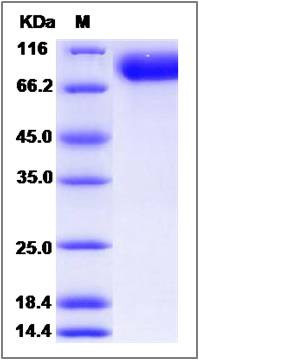Rat CD10 / Neprilysin / MME Protein (His Tag)
MME
- 100ug (NPP2987) Please inquiry
| Catalog Number | P80288-R07H |
|---|---|
| Organism Species | Rat |
| Host | Human Cells |
| Synonyms | MME |
| Molecular Weight | The recombinant rat MME comprises 719 amino acids and has a predicted molecular mass of 82.5 kDa. The apparent molecular mass of the protein is approximately 93 kDa in SDS-PAGE under reducing conditions. |
| predicted N | His |
| SDS-PAGE |  |
| Purity | > 95 % as determined by SDS-PAGE |
| Protein Construction | A DNA sequence encoding the rat MME (P07861) (Tyr52-Trp750) was expressed with a polyhistidine tag at the N-terminus. |
| Bio-activity | |
| Research Area | Neuroscience |Cell Type Marker in Neurodevelopment |Neural Stem Cell (NSC) Marker |
| Formulation | Lyophilized from sterile PBS, pH 7.4. 1. Normally 5 % - 8 % trehalose and mannitol are added as protectants before lyophilization. Specific concentrations are included in the hardcopy of COA. |
| Background | The cluster of differentiation (CD) system is commonly used as cell markers in immunophynotyping. Different kinds of cells in the immune system can be identified through the surface CD molecules which associating with the immune function of the cell. There are more than 320 CD unique clusters and subclusters have been identified. Some of the CD molecules serve as receptors or ligands important to the cell through initiating a signal cascade which then alter the behavior of the cell. Some CD proteins do not take part in cell signal process but have other functions such as cell adhesion. Cluster of differentiation 10 (CD10), also known as Neprilysin and neutral endopeptidase, is a member of the CD system. CD10 is a zinc-dependent metalloprotease enzyme that had function to degrade a number of small secreted peptides such as the amyloid beta peptide. It exist as a membrane-bound protein and have high concentration in kidney and lung tissues. Mutations in the CD10 gene can induce the familial forms of Alzheimer's disease, providing strong evidence for the protein's association with the Alzheimer's disease process. CD10 is also associated with other biochemical processes. |
| Reference |
